#docker engine
Explore tagged Tumblr posts
Text
enshittification isn't just worse UI changes. it's the fact that when i google a random word, the first result is usually some company. possibly multiple results about different companies. before anything useful.
#my posts#ok to rb#seriously pick a noun and google it. 'hyperfix' has hits on amazon before psychology websites#it's really frustrating because google is a better metasearch engine than many others that i've tried#thinking abt trying searx but also kinda lazy about trying to deal with figuring out how to configure docker and such#and i likey my firefox
6 notes
·
View notes
Text
Docker Engine 28 Fortalece la Seguridad de los Contenedores
Docker, la plataforma líder de código abierto para desarrollar, enviar y ejecutar aplicaciones en contenedores, ha lanzado oficialmente Docker Engine 28. Esta actualización introduce mejoras significativas en la seguridad de la red de contenedores, bloqueando el acceso a puertos no publicados desde redes locales (LAN) por defecto, lo que reduce los riesgos de exposición. Novedad Destacada:…
0 notes
Text
Docker-Compose is an indispensable tool for managing multi-container Docker applications. With a simple YAML file, you can define, configure, and deploy all the services your application needs.
0 notes
Text
CI CD Mastery for Cloud Infrastructure and Dive into DevOps book bundle offers!
CI CD Mastery for Cloud Infrastructure and Dive into DevOps book bundle offers! #sale #coding #programming #engineer #linux #cicd #devops #cloudinfrastructure #kubernetes #docker #sql #go #security
Here’s the link to check out the CI/CD Mastery for Cloud Infrastructure Book Bundle options with up to 22 items! CI/CD Mastery for Cloud Infrastructure Book Bundle Ready to make yourself indispensable? This comprehensive library from Packt is your springboard to mastering all aspects of the CI/CD pipeline for cloud infrastructure. Cloud Solution Architect’s Career Master Plan will provide you…

View On WordPress
#book#books#ci/cd#coder#coding#devops#docker#ebook#ebooks#engineer#humble bundle#kubernetes#Linux#no starch press#packt
0 notes
Text
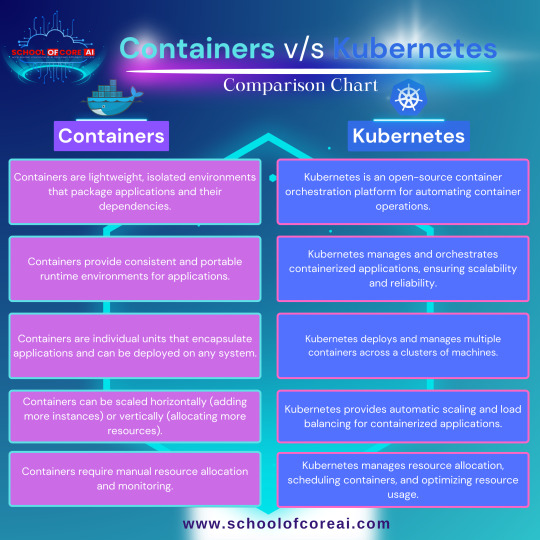
Visit here learn these Tools - Online or Offline
#machine learning#linux#docker#kubernetes#computer science#programming#ai tools#software engineering#application#education#career#datascience#data analytics#artificial intelligence
1 note
·
View note
Text
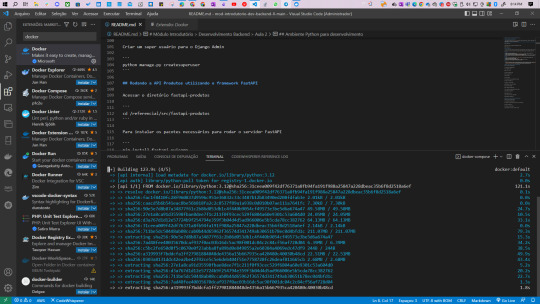
This is my second month in learning software engineering and now I finally know how to use docker.
1 note
·
View note
Text
Docker vs. Podman: Which One Floats Your Container Boat?
Let us tell you one thing.
This is not just an ordinary comparison between these two robust platforms.
Instead of that, we have analyzed and listed down the most burning questions regarding Docker vs Podman.
But here is a thing – these questions are not only surrounded by a technical perspective.
We’ve also dived into the business context, because we know that it’s not just about the code, it’s about making the right choices for your enterprise.
With this, you’ll be able to understand, evaluate, and execute the right tool for your containerization needs.
0 notes
Text
Learn Docker and kubernetes in 50+ hrs from Professionals. Join Docker Training @Bitaacademy and get your placement.

#dockers#Course#career#education#technology#engineering#itjobs#engineeringjobs#dockercontainer#dockerhub#dockerfile#dockerproducts#mlops#kubernetes#programmings#webdevelopment
0 notes
Text
Day 001 - establishing
Alrighty! Yesterday was productive if I had to say the least, I am glad when I talk to someone who gets my ideas, so I'm involved in the backend along with databases and anything devOps and AI related. My teammate is a stallion!!! I'm so glad there's someone who makes up for my coding skills, its very weird still, I USED TO BE ABLE TO CODE FOR HOURS AND HOURS... okay I think mostly because I used to program for hours either with Java or C++, and bare bone Javascript, so maybe web development wasn't my strong suit.

But I'm good at understanding and making designs for code, so I'm very involved in seeing the bigger picture and he'll just do the painting. Here's a screen shot of how our backend looks like, so I'm brush it up since its a bit of mess right now
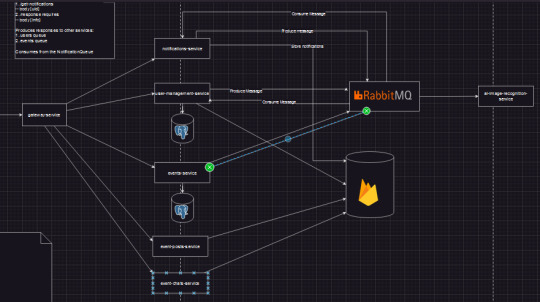
I'm using drawio because lucid just wasn't working for me, I kept running out of shapes, I'd say lucid is good when it comes to making final designs but drawio has that technical feel I like.
RabbitMQ is just so sexy oh my goodness, it allows for simple and fast communication between services. Its free tier is enough for what I need.
I want to learn PostgreSQL so bad, but I can't because we're on a time crunch and we'll just switch to MySQL for each service using an SQL database, since there's going to be data replication across these services, to maintain synchronized data across all services, RabbitMQ comes in the rescue. I hope it can handle, but since we'll starting off with a relatively small userbase, I doubt we'll run into problems, but if it happens we run into issues, I think switching to Kafka might be better since it has like faster reads (thanks to fewer systemcalls within its architecture)
Firestore is very useful and easy to setup, that reliability is useful for our messaging and posting of images, and also Firebase storage as well, that's so cool!!! I'm still working on the designs
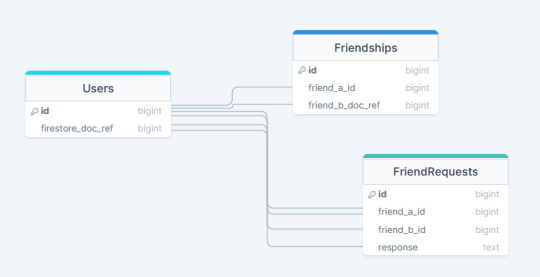
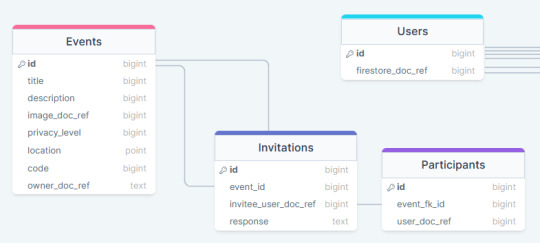
I'm still working on the schemas using drawsql website, the reason for the SQL is because its easier to model friendships, invitations, requests, way better than a NoSQL solution, I want to see what Neo4j can do but again I'm trying to keep things simple. I'll also switch to drawio for doing the ER diagrams because drawSQL has limits and I'm a cheapskate
I made use of freesqldatabase.com for a temporary online database we can quickly use, but this limits the choices for ORMs, since we're using NodeJS we can't make use of Prisma since it requires permissions/privileges that the website doesn't offer, but I'm working on making use of google cloud's free e2 instances to host the database, and if that works we finally have our development database!
I still haven't talked to my client, I'd rather someone from frontend do it, I hope they can finally start working together because I can't with this leadership biz! I am reading this leadership guide book, hopefully I learn something.
I've been also looking at buying some light novels for either rezero or overlord, boy boy boy which do I get??? I honestly don't know, but I"ll figure it out later. I can't wait to go a pawn shop and see what cheap board games I can buy, I'm so excited! But that will be a while.
Well my goals today are simple:
Finalize the schemas for the SQL databases and deploy the databases (or I can be cheap and deploy one instance and host 2 databases :D running two docker containers that have mysql on the same e2 instance and then mapping their default 3306 ports to two ports on the instance and then connecting globally! That's so brilliant I'm so cheap HAHAHAHAHA!!!!!!)
Draw up class diagrams for each service, making use of proper design patterns to make the code more neat
Have a meeting with my guy again and see where we go from there
Thanks again for reading my whatever this is, but its really fun hopefully I don't burn out from writing this much so early
0 notes
Text
Humans are Feral: Part 3
This is actually a continuation of the first part, but in a different scenario. I wanted to write a story with the idea of a human pack-bonding to an alien and going feral after seeing the alien hurt. It would a be a moment where aliens realize that while humans are dangerous, this kind of loyalty they can have for anyone or thing is a rarity and should be respected.
I also wanted to play around with the ideas of aliens reacting to human courtship. I’ve seen lots of headcannons and ideas as to how aliens may react to our openness when it comes to romantic relationships. Aka alien/monster fuckers. I hate you all because I am one of you.
So I decided to mix both and go with the scenario: what if a human’s alien S/O was threatened and hurt? I love the cliche of people going rabid after a loved one is hurt, it’s so nice to see humans actually caring for each other in this day and age.
WARNINGS - Implications of sexual trafficking, death, and violence.

Inter-species relationships were not an uncommon thing. However, they were met with equal skepticism and hate as they were welcome.
When humans joined the mix of races in the outer systems, it threw off those with prejudices against such relationships. While the young race was not without it it’s own trivial prejudices, the openness at which they had to forming lifepairs with non-human beings was unexpected. As humans branched out and their strange reputation became more than simple youngling stories, another reputation began to rise. That was of humans as life-mates.
While many still spurned others for finding partners outside their races, among the community it was seen as a huge honor to have a human as a life-mate. They were deemed high-maintenance and challenging to match, yet their loyalty held no bounds.
It wasn’t long before this became a small joke among the humans. They knew their species, and the idea the outer races had of them as lovers was too good not to joke about.
While they could not quell the rising rumors and fantastical stories surrounding their species, as much as it annoyed some, others took it in stride.
Quil’ian was a xicali of the dexi-10 planetary system, from the jungle planet Huvarrh. Stunningly large beasts, xicalis resembled bipedal humanoids with two pairs of arms and four fingered hands. Smooth, iridescent skin emblazoned with unique patterns covered their bodies. In dark spaces they often glowed with their own soft bioluminescence. Two large eyes of various dappled shades sat on either side of their flat noses. Scientists theorized that humans and xicalis must have had a similar evolutionary path from an ancestor of ape-like characteristics. But where humans remained in the ground, xicalis remained in the trees, their strong arms capable of immense strength for swinging from branch to branch.
Quil’ian was such a xicali. His skin shimmered a cerulean blue so deep it rivaled the gemstones of Farcauv. His eyes were pools of amber, one his partner said reminded them of a sweet syrup called honey from their home.
Quil’ian’s life partner was a human named Amira. She was a well-respected starship engineer from the eastern reaches of the Terran homeworld. Black hair, sun-darkened skin and eyes the color of rich garden soil. She had a laugh like the singing bird calls of his homeworld, and soft words of whispered sweetness that made his legs weak. She was the light of Quil’ian’s life.
When they were about in public and chose to display their affections, it more than often drew side glances. Scathing looks. Jealousy. Yearning. Disgust. They paid no mind.
They found work together, traveling to distant worlds and exploring the nether reaches of the universe. Amira would be hired on as an engineer for a ship, while Quil’ian would work as a docker, using his natural xicali strength to move shipments and ship parts. They made quite the pair for any employer.
It was on such a job, on the freelancer starship Queen Diogovay, they found themselves in a dangerous situation. Alien Marauders had attacked, demanding all shipment and valuable items. And the captain was going to let them have it. They weren't going to risk violence and an injured crew. Until the marauders realized there were humans aboard.
Ever since humans had entered the galactum, the trafficking industry boomed. The want for humans for servitude, experimentation, and especially sexual uses made humans beyond valuable. One pretty Terran could make over several billion kronor.
Upon the Queen Diogovay there were five human crew members, including Amira. And the marauders wanted every one of them. When the pirates first grabbed hold of the ship, three of the humans disappeared while Amira and Sam stayed with the crew to try to keep the trespassers at bay.
This proved to be of no use, as the bastards pushed their way past the barriers and blood was spilled without hesitation. Quil’ian made a split second decision and grabbed both Amira and Sam, throwing the pilot over his shoulders and his mate safely in his secondary arms. Then they were booking it down the hallway.
Quil’ian had it in his head to reach one of the evac pods before the pirates caught up to them. The Captain had been against using them to try to keep the ship and goods from the marauders, but they were most likely dead now, the orders void. And Quil’ian had decided from the start his mate was his first priority.
He was several turns from the pods when a kalik hound rounded the corner and slammed into them full force. A creature commonly used for violence, it opened its massive jaws and jumped at the xicali. Pain tore its way up Quil’ian’s leg, and he couldn’t think past the feeling of the hound’s fangs tearing his calf apart and Amira screeching like a jakvy bird. Then the feeling of the hound’s fangs disappeared as soon as they sunk in.
Quil’ian opened his eyes to see Amira atop the hound, arms wrapped around its throat as she attempted to choke it into submission. Sam had a metal pipe in their hands and was slamming into the hound’s face. The two were snarling and screaming right back at the alien dog, enough fury in their eyes to rival the violent creature. And Quil’ian watched as his mate tipped her head back and sunk her own teeth into the soft flesh of the beast’s neck.
It screamed, and Sam shoved the metal pipe down its throat, flesh tearing as the pole exited through the underside of its jugular. It fell to the ground thrashing, but the two humans doubled down in their efforts until the beast stilled. Quil’ian had never witnessed a hound fall so easily, the beasts known for their dexterity.
Then Amira was by his side, her mouth covered in the hound’s orange blood. Her hands made quick work of the sweatshirt she was wearing, tearing it into a single strip to wrap around the massacre that was the xicali’s leg. Her hands were gentle, a drastic change from the viciousness he just witnessed. The xicali stared at her for a moment, then concluded he would have been just as violent had the beast wrapped its jaws around her. If anything, a shiver went up his spine, one that was not unpleasant, at the realization that his human mate was willing to go to such drastic measures to protect him.
When the binding was done, Amira and Sam did their best to haul Quil’ian to his feet, the xicali towering above them. They made their way to the evac pods, spurred on by the distant yells and screeches from the marauders. It was both surprising and not when they got there and found the three other humans preparing the pods. One of them, Kaeveon, immediately went to their aid, muttering about the captain being a “fucking fool” and how they should have jumped as soon as the pirates boarded.
But all went calm as they entered the pod. The pirates were apparently too busy searching the entire Queen Diogovay for the missing humans to consider that they were already gone. In moments they were out in deep space, heading to the nearest station they could take refuge at. Amira was tucked into Quil’ian’s side for the whole duration, the couple refusing to let the other go. They treated the xicali’s injury with the med kit in the pod. It was enough the keep the woman from fussing over him too much, though her mate admitted to himself that he was rather basking in her concerned care.
Perhaps, after this incident, Quil’ian would try to convince her to settle somewhere. Maybe back on his home planet, in a small home in the trees, with a view she would love.

I’m sorry this took forever to put out. Not my best work since I started it months ago and lost the motivation until now. My mental health hasn’t been the best these pst few months, but we’re on the up, and writing this has definitely put some inspiration back on the table. Hope y’all enjoy this smaller snippet. And I really like the possibilities with Quil’ian and Amira, so maybe I’ll have some more stories starring them.
#humans are space orcs#humans are crazy#humans are space australians#humans are deathworlders#humans are weird#my writing#shower thoughts#humans are feral series
233 notes
·
View notes
Text
If I’m being honest, the most useful skill for hacking is learning to do research. And since Google’s search is going to shit, allow me to detail some of the methods I use to do OSINT and general research.
Google dorking is the use of advanced syntax to make incredibly fine-grained searches, potentially exposing information that wasn’t supposed to be on the internet:
Some of my go-to filters are as follows:
“Query” searches for documents that have at least one field containing the exact string.
site: allows for a specific site to be searched. See also inurl and intitle.
type: specifies the tor of resource to look for. Common examples are log files, PDFs, and the sitemap.xml file.
Metasearch engines (such as SearxNG) permit you to access results from several web-crawlers at once, including some for specialized databases. There are several public instances available, as well as some that work over tor, but you can also self-host your own.
IVRE is a self-hosted tool that allows you to create a database of host scans (when I say self-hosted, I mean that you can run this in a docker container on your laptop). This can be useful for finding things that search engines don’t show you, like how two servers are related, where a website lives, etc. I’ve used this tool before, in my investigation into the Canary Mission and its backers.
Spiderfoot is like IVRE, but for social networks. It is also a self-hosted database. I have also used this in the Canary Mission investigation.
Some miscellaneous websites/web tools I use:
SecurityTrails: look up DNS history for a domain
BugMeNot: shared logins for when creating an account is not in your best interest.
Shodan/Censys: you have to make an account for these, so I don’t usually recommend them.
OSINT framework: another useful index of tools for information gathering.
40 notes
·
View notes
Note
hey builderman , i need help :( how do i model a 3d cube 💔
Well, that's the great thing about our game engine, you don't have to use any third party programs!!
Open Roblox Studio and search for this little window! Basic objects!

Just search for and import a part from here! To make it a square just make it the same studs long as it's tall!
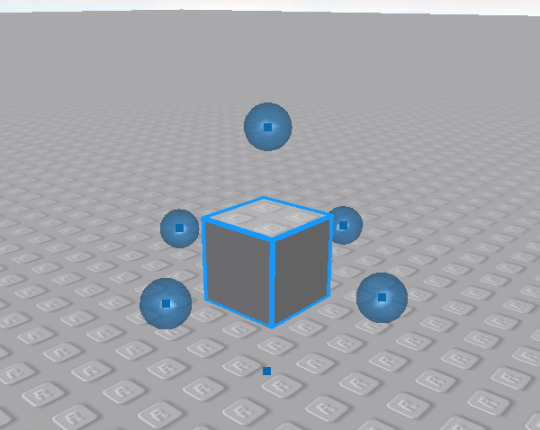
Tada!!! :D
Now it should show up in Explorer under 'Workspace.' Just select that, go to the Properties docker and edit whatever properties you want!
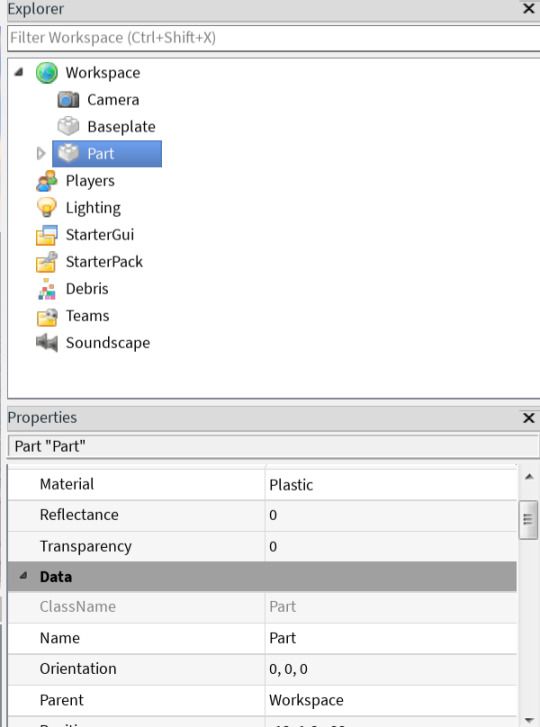
Good luck building creator!!
#NAMELESS VOICE#if you wondering how i got the 2010s version of studio#its a game#retrostudio#go check it out if ya miss old roblox#block tales#block tales roblox#block tales hatred
17 notes
·
View notes
Text
📝 Guest Post: Local Agentic RAG with LangGraph and Llama 3*
New Post has been published on https://thedigitalinsider.com/guest-post-local-agentic-rag-with-langgraph-and-llama-3/
📝 Guest Post: Local Agentic RAG with LangGraph and Llama 3*
In this guest post, Stephen Batifol from Zilliz discusses how to build agents capable of tool-calling using LangGraph with Llama 3 and Milvus. Let’s dive in.
LLM agents use planning, memory, and tools to accomplish tasks. Here, we show how to build agents capable of tool-calling using LangGraph with Llama 3 and Milvus.
Agents can empower Llama 3 with important new capabilities. In particular, we will show how to give Llama 3 the ability to perform a web search, call custom user-defined functions
Tool-calling agents with LangGraph use two nodes: an LLM node decides which tool to invoke based on the user input. It outputs the tool name and tool arguments based on the input. The tool name and arguments are passed to a tool node, which calls the tool with the specified arguments and returns the result to the LLM.
Milvus Lite allows you to use Milvus locally without using Docker or Kubernetes. It will store the vectors you generate from the different websites we will navigate to.
Introduction to Agentic RAG
Language models can’t take actions themselves—they just output text. Agents are systems that use LLMs as reasoning engines to determine which actions to take and the inputs to pass them. After executing actions, the results can be transmitted back into the LLM to determine whether more actions are needed or if it is okay to finish.
They can be used to perform actions such as Searching the web, browsing your emails, correcting RAG to add self-reflection or self-grading on retrieved documents, and many more.
Setting things up
LangGraph – An extension of Langchain aimed at building robust and stateful multi-actor applications with LLMs by modeling steps as edges and nodes in a graph.
Ollama & Llama 3 – With Ollama you can run open-source large language models locally, such as Llama 3. This allows you to work with these models on your own terms, without the need for constant internet connectivity or reliance on external servers.
Milvus Lite – Local version of Milvus that can run on your laptop, Jupyter Notebook or Google Colab. Use this vector database we use to store and retrieve your data efficiently.
Using LangGraph and Milvus
We use LangGraph to build a custom local Llama 3-powered RAG agent that uses different approaches:
We implement each approach as a control flow in LangGraph:
Routing (Adaptive RAG) – Allows the agent to intelligently route user queries to the most suitable retrieval method based on the question itself. The LLM node analyzes the query, and based on keywords or question structure, it can route it to specific retrieval nodes.
Example 1: Questions requiring factual answers might be routed to a document retrieval node searching a pre-indexed knowledge base (powered by Milvus).
Example 2: Open-ended, creative prompts might be directed to the LLM for generation tasks.
Fallback (Corrective RAG) – Ensures the agent has a backup plan if its initial retrieval methods fail to provide relevant results. Suppose the initial retrieval nodes (e.g., document retrieval from the knowledge base) don’t return satisfactory answers (based on relevance score or confidence thresholds). In that case, the agent falls back to a web search node.
The web search node can utilize external search APIs.
Self-correction (Self-RAG) – Enables the agent to identify and fix its own errors or misleading outputs. The LLM node generates an answer, and then it’s routed to another node for evaluation. This evaluation node can use various techniques:
Reflection: The agent can check its answer against the original query to see if it addresses all aspects.
Confidence Score Analysis: The LLM can assign a confidence score to its answer. If the score is below a certain threshold, the answer is routed back to the LLM for revision.
General ideas for Agents
Reflection – The self-correction mechanism is a form of reflection where the LangGraph agent reflects on its retrieval and generations. It loops information back for evaluation and allows the agent to exhibit a form of rudimentary reflection, improving its output quality over time.
Planning – The control flow laid out in the graph is a form of planning, the agent doesn’t just react to the query; it lays out a step-by-step process to retrieve or generate the best answer.
Tool use – The LangGraph agent’s control flow incorporates specific nodes for various tools. These can include retrieval nodes for the knowledge base (e.g., Milvus), demonstrating its ability to tap into a vast pool of information, and web search nodes for external information.
Examples of Agents
To showcase the capabilities of our LLM agents, let’s look into two key components: the Hallucination Grader and the Answer Grader. While the full code is available at the bottom of this post, these snippets will provide a better understanding of how these agents work within the LangChain framework.
Hallucination Grader
The Hallucination Grader tries to fix a common challenge with LLMs: hallucinations, where the model generates answers that sound plausible but lack factual grounding. This agent acts as a fact-checker, assessing if the LLM’s answer aligns with a provided set of documents retrieved from Milvus.
```
### Hallucination Grader
# LLM
llm = ChatOllama(model=local_llm, format="json", temperature=0)
# Prompt
prompt = PromptTemplate(
template="""You are a grader assessing whether
an answer is grounded in / supported by a set of facts. Give a binary score 'yes' or 'no' score to indicate
whether the answer is grounded in / supported by a set of facts. Provide the binary score as a JSON with a
single key 'score' and no preamble or explanation.
Here are the facts:
documents
Here is the answer:
generation
""",
input_variables=["generation", "documents"],
)
hallucination_grader = prompt | llm | JsonOutputParser()
hallucination_grader.invoke("documents": docs, "generation": generation)
```
Answer Grader
Following the Hallucination Grader, another agent steps in. This agent checks another crucial aspect: ensuring the LLM’s answer directly addresses the user’s original question. It utilizes the same LLM but with a different prompt, specifically designed to evaluate the answer’s relevance to the question.
```
def grade_generation_v_documents_and_question(state):
"""
Determines whether the generation is grounded in the document and answers questions.
Args:
state (dict): The current graph state
Returns:
str: Decision for next node to call
"""
print("---CHECK HALLUCINATIONS---")
question = state["question"]
documents = state["documents"]
generation = state["generation"]
score = hallucination_grader.invoke("documents": documents, "generation": generation)
grade = score['score']
# Check hallucination
if grade == "yes":
print("---DECISION: GENERATION IS GROUNDED IN DOCUMENTS---")
# Check question-answering
print("---GRADE GENERATION vs QUESTION---")
score = answer_grader.invoke("question": question,"generation": generation)
grade = score['score']
if grade == "yes":
print("---DECISION: GENERATION ADDRESSES QUESTION---")
return "useful"
else:
print("---DECISION: GENERATION DOES NOT ADDRESS QUESTION---")
return "not useful"
else:
pprint("---DECISION: GENERATION IS NOT GROUNDED IN DOCUMENTS, RE-TRY---")
return "not supported"
```
You can see in the code above that we are checking the predictions by the LLM that we use as a classifier.
Compiling the LangGraph graph.
This will compile all the agents that we defined and will make it possible to use different tools for your RAG system.
```
# Compile
app = workflow.compile()
# Test
from pprint import pprint
inputs = "question": "Who are the Bears expected to draft first in the NFL draft?"
for output in app.stream(inputs):
for key, value in output.items():
pprint(f"Finished running: key:")
pprint(value["generation"])
```
Conclusion
In this blog post, we showed how to build a RAG system using agents with LangChain/ LangGraph, Llama 3, and Milvus. These agents make it possible for LLMs to have planning, memory, and different tool use capabilities, which can lead to more robust and informative responses.
Feel free to check out the code available in the Milvus Bootcamp repository.
If you enjoyed this blog post, consider giving us a star on Github, and share your experiences with the community by joining our Discord.
This is inspired by the Github Repository from Meta with recipes for using Llama 3
*This post was written by Stephen Batifol and originally published on Zilliz.com here. We thank Zilliz for their insights and ongoing support of TheSequence.
#ADD#agent#agents#amp#Analysis#APIs#app#applications#approach#backup#bears#binary#Blog#bootcamp#Building#challenge#code#CoLab#Community#connectivity#data#Database#Docker#emails#engines#explanation#extension#Facts#form#framework
0 notes
Text
So in this world of rising streaming costs and license holders unilaterally deciding to pull content from streaming channels I figured I'd compile a few guides for people who want to cut those cords. As a rhetorical exorcise I'm going to list out some guides on how someone might want to create their own local media streaming service and how to automate management and supply of content to it. ALL RHETORICAL
I'm not going to explain how to build a media server, people who go that extensive won't need these guides, but if you have the cash, and don't want to build your own server you can always buy a higher end NAS from synology or QNAP that runs docker engine and you should be good.
Please make sure to follow the instructions for each individual guide in order depending on your choices. RHETORICALLY.
First you install Docker:
https://www.virtualizationhowto.com/2023/02/docker-compose-synology-nas-install-and-configuration/
Then you install your download clients:
Newsgroups (you'll also need an account with a hosting service like Newshosting or Giganews as well as access to an indexer): https://drfrankenstein.co.uk/2021/07/30/setting-up-nzbget-in-docker-on-a-synology-nas/
Torrents (with this you'll need access to either public or private trackers): https://drfrankenstein.co.uk/2021/09/13/deluge-in-docker-on-a-synology-nas/
Then you install Jackett (this'll auto-manage all of your torrent trackers and create feeds for Sonarr and Radarr):
https://www.smarthomebeginner.com/install-jackett-using-docker/
Then you install Sonarr:
https://drfrankenstein.co.uk/2021/05/03/setting-up-sonarr-in-docker-on-a-synology-nas/
Then you install Radarr:
https://drfrankenstein.co.uk/2021/07/30/setting-up-radarr-in-docker-on-a-synology-nas/
Then you install Plex or Jellyfin:
Plex: https://drfrankenstein.co.uk/2021/12/06/plex-in-docker-on-a-synology-nas/
Jellyfin: https://drfrankenstein.co.uk/2022/09/03/jellyfin-in-docker-on-a-synology-nas-no-hardware-transcoding/
Then you install Overseerr or Jellyseerr:
Overseerr: https://drfrankenstein.co.uk/2022/03/19/overseerr-in-docker-on-a-synology-nas/
Jellyseerr (only use if you picked Jellyfin): https://drfrankenstein.co.uk/2022/09/04/jellyseerr-in-docker-on-a-synology-nas/

#streaming#media streaming#streaming sites#nas#network access storage#synology#qnap#plex#jellyfin#jellyseer#sonarr#radarr#overseerr#cause why the hell not
63 notes
·
View notes
Text
Roger McGough was a docker’s son who went to university, and in his poems caught the wayward nature of Liverpool speech. 0f the musicians, only John Lennon really matched him for that. It’s not surprising that McGough was drafted in by the makers of Yellow Submarine to give its script a tang of that Scouse whimsy which could easily pass as psychedelia.
His parallel pop career began when he met Paul McCartney’s younger brother Mike. Though employed by day in Andre Bernard’s hairdressing salon (an establishment for upmarket ladies, opposite the Adelphi; it’s now a burger joint), McCartney had artistic ambitions: he designed posters for his brother’s band and was infatuated by photography and Surrealism. He found his way up Mount Pleasant to the basement of the Hope Hall (later re-styled as the Everyman Bistro) where a curious group of young experimentalists were gathering. There they were, these strange people,’ Mike recalls, ‘Adrian Henri, Roger McGough, John Gorman - he was a telephone engineer, who knew how to make free phone calls all over the world - the painter Sam Walsh. It didn’t have a name, it was just a collection of people. In fact it was originally called the Merseyside Arts Festival.
‘We attracted this underground movement: Ginsberg and the beat poetry was getting to Liverpool then. Merseybeat was going on at the same time. We’re doing this up in Hope Street, our kid and the beat groups were down in the centre of town, in the Cavern. We’re near the art school and the university. That’s your marketplace. So our thing was different: it was poetry, art, comedy, rhythm and blues. We’d go into town to see the Beatles and sometimes they’d come up to see us.’
One day the TV people came to Liverpool to investigate these mixed-media happenings. McCartney, by now trading as Mike McGear, was performing comic sketches with a Joose grouping called the Liverpool One Fat Lady All-Electric Show. It was the TV people who picked a trio from the chaos: in Gorman, McGough and McGear they’d found a talented clown, a bespectacled intellectual and a good-looking boy whose brother was in the Beatles. The new group took its name, the Scaffold, from a Miles Davis record.
‘We were satirists,’ says McCartney. ‘Our main thing was to comment on life. A ladies’ barber, a Post Office engineer and an English teacher, jobs for life, and they dangled this carrot, said “Would you like to go on the telly?” So all these serious jobs, we just jacked them in. We realised that when comedy got to a wider audience it would be good to include music. We couldn’t do rock’n’roll because we couldn’t sing or play instruments. But we had this Cockney dirge, “2day’s Monday”, and George Martin was interested in producing it. We liked that idea, not because of the Beatles but because he did the Goons. We went on Juke Box Jury with it and Spike Milligan said, If there was a comedy chart this would go to Number 1.
‘Now that we were involved with George Martin and EMI we went to Brian Epstein and said, You’ve got all the pop groups, but can you do a theatre comedy group? Eie goes “My dear boy!” - ’cos he was a failed actor - “Of course. We’d love to have you aboard.” So we thought, with his enormous NEMS agency we had nothing to lose.’ But the Scaffold were frustrated by Epstein’s stalling over their next single, ‘Goodbat Nightman,’ built around McGough’s wry commentary on the Batman craze then raging. ‘It was released too late. Died a death.
We got disillusioned with Brian after that. I went out with him in Wheeler’s in London and said “Brian, it’s like a racetrack and we’re on the outside. All your heavyweights, the Beatles and Cilia and Gerry are on the inside. It’s just not working for us.” He says, “Oh I quite agree, Michael.” I felt like hitting him, to tell you the truth. So we left. ‘There was this other song I’d written where we’d thank the audience for coming along: “Thank you very much for keepin’ the seats warm” and so on, just to close our show. So we recorded “Thank U Very Much”, a good strong track. We had a hit there - it was Harold Wilson’s favourite record - and it got us on the telly in a major way. Top of the Pops!’
By November 1968, Paul was no longer the only McCartney brother to top the charts: the Scaffold scored a Christmas Number 1 with ‘Lily the Pink’. The song was just as insanely memorable as Thank U Very Much’. And thanks to Lily, the Scaffold were propelled from a world of fringe theatre groups and college satire fans, on to the lucrative cabaret circuit. ‘We’d created this monster of success,’ says Mike, ‘but it was the wrong success and we got disenchanted. You stuck to your songs and played the same bloody thing every night. We were bored and the audience was bored. That’s the tragedy of Scaffold, that we were known more for the silly songs because they reached more people, than the stuff we really enjoyed doing, the satirical comedy and the poetry.’
So the Scaffold resigned from pop and submerged their act inside a new ensemble, Grimms: the name came from their initials plus those of Andy Roberts from the Liverpool Scene and Neil Innes and Vivian Stanshall of the Bonzo Dog Band. (It was Mike who’d secured the Bonzos’ appearance in the Beatles’ Magical Mystery Tour.) There were contributions too from Adrian Henri, Brian Patten and others. Grimms’ shows were an often inspired collage of rock, comedy and poetry, and a chance for the ex-Scaffolders to rediscover the edgier aspects of their act. But the troupe was unwieldy, bedevilled by drink and personality clashes. One night, as their tour bus reached Huyton, McGear declared, ‘Stop the coach, 1 want to get off. And I did.’
The Scaffold re-appeared a few years later, signed to Warners by Derek Taylor, where Paul McCartney produced a stirring version of the Dominic Behan folk song ‘Liverpool Lou’. Mike McCartney would subsequently concentrate on photography; Gorman became a regular on children’s TV. McGough remains that rare thing, a genuinely popular poet; in 1996 he collected an OBE from Buckingham Palace on the same day as Cilia Black, while Paul McCartney became a knight of the realm.
(Liverpool - Wondrous Place by Paul Du Noyer, 2002)
Part (I), (II), (III), (IV), (V), (VI), (VII), (VIII), (IX), (X), (XI), (XII), (XIII), (XIV), (XV), (XVI), (XVII), (XVIII), (XIX), (XX), (XXI), (XXII)
5 notes
·
View notes
Text


[ 19th february, 2024 • DAY 8/145 ]
nothing screams software engineering quite like 20 lines of ERR!! in bright red.. 💔
-> finally managed to install docker and run the backend but now i'm having trouble with the frontend welp
-> walked back from uni (30 mins, it was sunny)
-> weights session
-> played The Sims 2
also, i need to start using my time better. time to figure out how to do that
#stargazerbibi#study#studyblr#100 dop#100 days of productivity#studyspo#student#studyspiration#studystudystudy#aesthetic#productivity#student life#studying#studies#study blog#studygram#study motivation#college#college life#uni#uniblr#uni life#university#stem#stem studyblr#stemblr#stem girls
45 notes
·
View notes